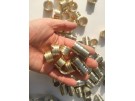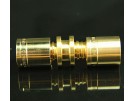Tech News
forge something you make a mold out of very good steel. You put a plate of the metal you want to forge between the two halves of a mold, and squeeze the mold. HARD! As in many tens (and for large things, hundreds) of tons, from a press that may outweigh your house. (The moveable half of the mold is called a "tool"; the stationary half is called a "die.") The metal flows like toothpaste, and when you open the mold, you have your part. A little finishing, and its ready to use. Its an expensive process to set up (the molds are very expensive to make, and the press, while quite simple, is huge, and costs accordingly) but if you make a lot of something, it can be quite cheap. The lump of metal can be cold (by metal standards, 1/3 of its melting point) or hot (near the melting point, about the only option if you want to forge iron).

Other common processes are
casting (pouring liquid metal into a mold) and CNC (Computer Numeric Control) machining. The strongest result is usually from forging. As metal cools, it forms "grains". The grains are strong, but they don't "stick" to each other perfectly. So castings may well break, and if you look at the break, it will show a bumpy "matte" surface, as it will have separated between individual grains. In metalurgists terms, it shows poor ductility.

the tougher the part. A break may actualy show a fairly shiny surface, as the space between the "grains" is gone. The direction of flow as the metal is squeezed imparts a grain structure to the metal that is a bit like that of wood, making it substantially stronger in specific directions. Well-designed forging tools and dies control this flow so as to make the part strongest in the directions it is expected to be stressed
in.













